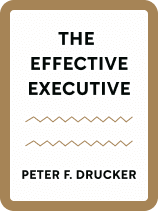

This article is an excerpt from the Shortform book guide to "The Effective Executive" by Peter F. Drucker. Shortform has the world's best summaries and analyses of books you should be reading.
Like this article? Sign up for a free trial here .
What is The Effective Executive about? What can you do to increase the effectiveness of your organization?
In his book The Effective Executive, Peter Drucker argues that effectiveness derives from a set of five practices anyone can learn rather than from unique talents or charisma. Drucker’s five effectiveness practices are as follows: 1) manage your time, 2) focus, 3) make a unique contribution, 4) maximize your strengths, and 5) make sound decisions.
This article examines how Drucker’s ideas on effectiveness hold up today and how others have built on them.
The Effective Executive: The Definitive Guide to Getting the Right Things Done
While many business books tell you how to manage other people, Peter Drucker’s The Effective Executive explains how to manage yourself to be effective.
Drucker defines effectiveness as choosing and doing the right things—that is, the things that significantly improve personal and organizational performance and results.
A leader in management theory and practice for over 60 years, Drucker, who died in 2005, authored 39 books and countless articles, including more than 30 essays in the Harvard Business Review. He’s credited with being the founder of modern management.
(Shortform note: Drucker’s obituary in the New York Times noted that his ideas on management were so influential that a comment from him could change the way top corporate leaders operated. His thinking has continued to inspire business leaders and authors—for example, the late Jack Welch, Tom Peters, Jim Collins (Good to Great), Ken Blanchard, Andrew Grove (High Output Management), Jeff Bezos, Stephen Covey (The 7 Habits of Highly Effective People), and Tim Ferriss (The 4-Hour Workweek).)
Practice #1: Manage Your Time
Drucker’s first practice for effectiveness is managing your time. He argues that you first need to understand what you’re currently doing with your time then take control of it. There are three steps: Analyze your time, cut time wasters, and time block. (Shortform note: Drucker’s approach differs from the advice in many time management books such as Getting Things Done and The One Thing. These books recommend immediately determining and focusing on what’s most important (prioritizing), rather than first analyzing how you currently spend your time.)
1. Analyze Your Time
Drucker’s guidelines for tracking and analyzing your time are:
- Keep a log as you do things, recording everything you do and how long it takes. Do this for three or four weeks at a time, twice a year. The specific method or format you use doesn’t matter. (Shortform note: Time tracking apps such as RescueTime may be useful, particularly for automatically tracking what you’re doing on-screen—an increasingly large proportion of time use that provides myriad opportunities for distraction. Like this knowledge worker who tracked his time, you may be surprised at how little focused work you’re accomplishing.)
- After each recorded period, rethink and revise your schedule (see Step 2). Many people slide back into a pattern of wasting time in about six months, Drucker says, so it takes constant vigilance and adjustment to prevent this drifting. (Shortform note: The Happiness Project recommends taking daily notes about what worked—what you accomplished, when, and how—in order to identify and replicate your most productive habits and times, so you can make them routine.)
2. Cut Time Wasters
Once you’ve recorded your time for a few weeks, Drucker advises rooting out your time-wasting activities with these steps:
1) Identify and eliminate activities that don’t produce results, including things that don’t need to be done in the first place. For each item on your time record, ask yourself what would happen if you hadn’t done it or don’t do it going forward. If the answer is nothing, stop doing it. Drucker claims that most executives could eliminate about 25% of their activities without anyone noticing; he cites speeches, social events, committee memberships, directorships, and lunch or dinner events as often unnecessary.
(Shortform note: Today, such activities might be considered essential parts of branding, marketing, or networking. A way to evaluate these activities and decide if they’re useful enough to continue is to borrow the lean manufacturing idea of determining which ones are value-added versus non-value-added: Value-added activities add customer value to a business process, product, or service. This aligns with Drucker’s advice to say “no” to doing anything that doesn’t help your organization or enhance your contribution to the organization’s performance.)
2) Determine which activities could be done by someone else, and delegate them. While some people view delegating as being lazy or taking advantage of a subordinate, Drucker emphasizes that as an executive, you’re being paid for your unique contribution to the organization’s performance—and when you allow yourself to be distracted from this by tasks someone else can do, you undercut your effectiveness as well as the organization’s.
3) Identify the ways in which you waste others’ time (and therefore your own). Drucker advises asking your employees and colleagues what you do that wastes their time (that doesn’t increase their effectiveness or contribution).
You may be doing something that’s productive for you but that still wastes others’ time—for example, requiring an employee to track weekly data and produce a report that you rarely refer to.
4) Cut time-wasters resulting from poor management. Drucker identifies several types of time-wasters resulting from poor management. Chief among them is wasting time with an excessive number of meetings, which keeps executives and others from getting important work done. (Shortform note: A 2017 HBR article noted that executives spend about 23 hours a week in meetings, up from 10 hours in the 1960s. Other surveys and estimates range much higher—for example, 45 hours a week or 72% of their time.)
Drucker says meetings should be the exception rather than the rule. They are sometimes needed—people have to cooperate by sharing knowledge and information to get a specific task done. But to avoid wasting time, meetings should be focused.
3. Time Block
The third step for managing your time (after analyzing it and cutting time-wasters), according to Drucker, is to make the most of the little nonscheduled time you have left (your discretionary time for important tasks that contribute significantly to your company’s performance). He says this typically amounts to only 25% of your total time.
The way to make the most of this time is to consolidate it into blocks as large as possible. Drucker contends that small increments of time are useless—you can’t write a report by spending 15 minutes on it a day. If you try, you won’t get anywhere and will have to start over the next time. But if you can get four or five hours of uninterrupted time, you can create a solid draft that you can flesh out later in smaller time increments. (Shortform note: While time blocking (also called time boxing) is widely recommended and practiced today, it was new when Drucker first wrote about it.)
Practice #2: Focus
The second practice for effectiveness is focus, which Drucker defines as focusing on only a few key things and doing them one at a time. (Shortform note: Drucker actually lists focus as his fourth practice. We’ve moved it to #2 because it encompasses prioritizing, which is closely related to Practice #1, managing your time.)
Drucker says the ability to focus is central to executive performance because:
- When you focus on one thing at a time, you actually get more done because you get each thing done faster. You also do better work, which strengthens your contribution to organizational performance. (Shortform note: In Quiet, Susan Cain notes that focusing may be easier for introverts than for extroverts, because introverts’ preferred work style is to work methodically on one task at a time and concentrate deeply.)
- You can’t do more than one thing at a time well. (Shortform note: Drucker was ahead of the research in realizing that multitasking yields poor results. We’ll discuss the myth of multitasking below.)
Determine Priorities and Non-Priorities
After eliminating unproductive activities, Drucker’s next step is deciding which productive tasks and opportunities are priorities—the right tasks on which you concentrate one at a time—and which are non-priorities, things you don’t do.
While most people focus on determining priorities, Drucker contends that consciously deciding your non-priorities is equally important, because non-priorities tend to encroach on priorities unless you actively resist or eliminate them. Non-priorities are tasks you’ve decided you won’t do or opportunities you won’t pursue now, if at all. These are activities that offer little or no significant long-term value.
Priorities
Drucker doesn’t give any specific advice on how to set priorities—he says setting priorities requires courage more than analysis. In his view, courage requires that you:
- Favor the future over the past. Successful companies are those that innovate rather than build on existing products.
- Focus on opportunities, not problems. It’s more valuable to translate an opportunity into results for the future than to solve a current problem.
Practice #3: Make Your Unique Contribution
Drucker’s third practice for effectiveness is determining and applying your unique contribution. This means looking beyond your immediate work or task and being guided by the larger question, “What unique contribution can I make to significantly increase organizational performance and results?”
Drucker advises you to take responsibility for your own contribution and results, then request the same from your employees by asking, “What contribution do you intend to make, and what’s our best use of your contribution (knowledge and ability)?” Finally, only hold meetings if their purpose advances your contribution to the organization.
Practice #4: Maximize Strengths—Yours and Others’
The fourth practice for effectiveness is building or leveraging strengths—your own strengths and the strengths of those around you—to achieve results.
Drucker argues that you can’t accomplish anything significant by focusing on your own or others’ weaknesses. When you focus on weaknesses, you undermine the purpose of the organization, which is to translate people’s strengths into performance for results. He says that morally, managers owe it to the organization to maximize the strength of every employee, and owe it to employees to enable them to excel to the extent possible.
Practice #5: Make Sound Decisions
Drucker’s fifth and final practice for effectiveness is making sound decisions. He lays out a five-step process:
Step 1: Determine whether the situation requiring a decision is typical or unique. If it’s typical, it can be solved by applying a principle or rule.
Step 2: Determine the objectives the decision must meet, and the limitations or constraints (such as budget) affecting the solution.
Step 3: In considering options, focus on the right action rather than the acceptable action (this sets a benchmark before making any compromises or concessions with the decision).
Step 4: As part of the decision, determine how it will be implemented (otherwise, it’s just an intention).
Step 5: Establish a feedback mechanism for testing whether the decision works.

———End of Preview———
Like what you just read? Read the rest of the world's best book summary and analysis of Peter F. Drucker's "The Effective Executive" at Shortform .
Here's what you'll find in our full The Effective Executive summary :
- How to manage yourself before you can manage others
- The five practices that anyone can learn to be more effective
- Why leaders should purposely create disagreements






